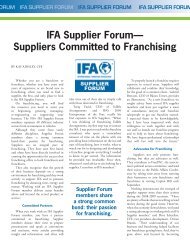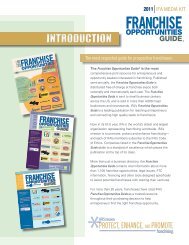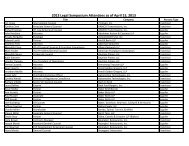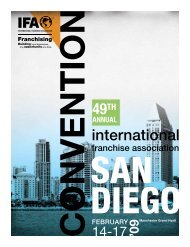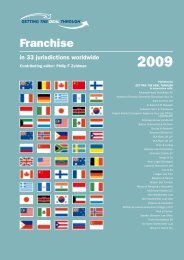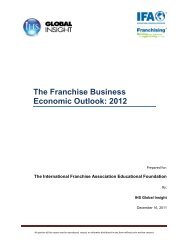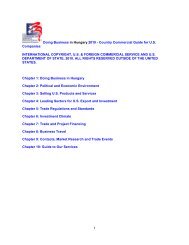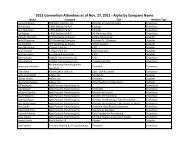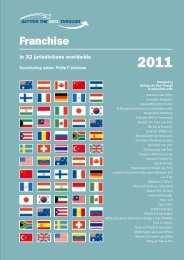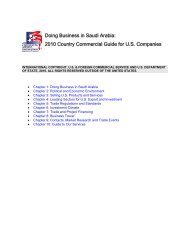South Africa - International Franchise Association
South Africa - International Franchise Association
South Africa - International Franchise Association
Create successful ePaper yourself
Turn your PDF publications into a flip-book with our unique Google optimized e-Paper software.
Return to table of contents<br />
Chapter 5: Trade Regulations, Customs and Standards<br />
• Import Tariffs<br />
• Trade Barriers<br />
• Import Requirements and Documentation<br />
• U.S. Export Controls<br />
• Temporary Entry<br />
• Labeling and Marking Requirements<br />
• Prohibited and Restricted Imports<br />
• Customs Regulations and Contact Information<br />
• Standards<br />
• Trade Agreements<br />
• Web Resources<br />
Import Tariffs Return to top<br />
As a result of the Uruguay Round in 1994, <strong>South</strong> <strong>Africa</strong> reformed and simplified its tariff<br />
structure. Tariff rates have been reduced from a simple average of more than 20<br />
percent to an average of 5.8 percent. Notwithstanding these reforms, importers have<br />
complained that the tariff schedule remains unduly complex, with nearly forty different<br />
rates. Tariff rates mostly fall within eight levels ranging from 0 percent to 30 percent, but<br />
some are higher (e.g. most apparel items).<br />
Nearly all of <strong>South</strong> <strong>Africa</strong>’s specific and composite duties were converted to ad valorem<br />
rates (a tax, duty, or fee which varies based on the value of the products, services, or<br />
property on which it is levied), with a few exceptions remaining in a limited number of<br />
sectors, including textile and apparel products.<br />
In the Uruguay Round, <strong>South</strong> <strong>Africa</strong> agreed to a twelve-year phase-down process. The<br />
end rate for apparel is 40 percent, yarns, 15 percent; fabrics, 22 percent; finished goods,<br />
30 percent; and fibers, 7.5 percent. The effective rated duty rates on cars, light vehicles,<br />
and minibuses is still at the high level of 34 percent, while the rate of duty on original<br />
motor parts is 20 percent.<br />
The dutiable value of goods imported into <strong>South</strong> <strong>Africa</strong> is calculated on the f.o.b. (free on<br />
board) price in the country of export, in accordance with the WTO (ex-GATT) Customs<br />
Valuation Code. The value for customs duty purposes is the transaction value, or the<br />
price actually paid or payable.<br />
In cases where the transaction value cannot be determined, the price actually paid for<br />
similar goods, adjusted for differences in cost and charges based on distance and mode<br />
of transport, is regarded as the transaction value. If more than one transaction value is<br />
determined, the lowest value applies. Alternatively, a computed value may be used<br />
based on production costs of the imported goods. In the case of related buyers and<br />
sellers, the transaction value will be accepted if, in the opinion of the Commissioner for<br />
Customs, the relationship does not influence the price, or if the importer shows that the





